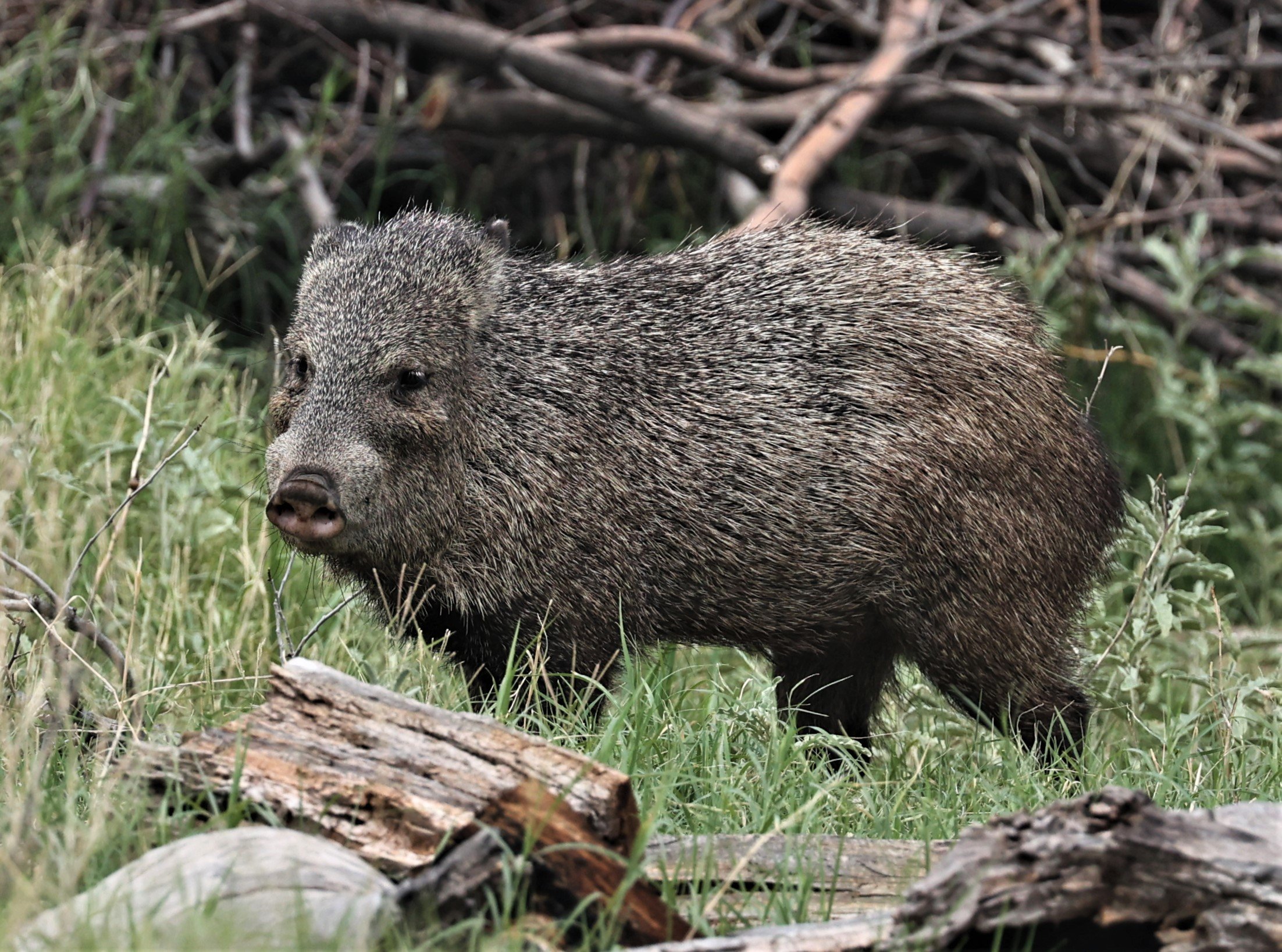Peccaries
A Peccary (also Javelina or skunk pig) is a medium-sized, pig-like ungulate of the family Tayassuidae (New World pigs). They are found throughout Central and South America, Trinidad in the Caribbean, and in the southwestern area of North America. They usually measure between 90 and 130 cm (2 ft 11 in and 4 ft 3 in) in length, and a full-grown adult usually weighs about 20 to 40 kg (44 to 88 lb). They represent the closest relatives of the family Suidae, which contains pigs and relatives. Together Tayassuidae and Suidae are grouped in the suborder Suina within the order Artiodactyla (even toed ungulates).
Peccaries are social creatures that live in herds. They are omnivores and eat roots, grubs, and a variety of other foods. They can identify each other by their strong odors. A group of peccaries that travel and live together is called a squadron. A squadron of peccaries averages between six and nine members.
Peccaries first appeared in North America during the Miocene and migrated into South America during the Pliocene–Pleistocene as part of the Great American Interchange.
Peccary distribution in North & South America.
They are often confused with feral domestic pigs, commonly known as "razorback" hogs in many parts of the United States, when the two occur in the wild in similar ranges.
Three (possibly four) living species of peccaries are found from the Southwestern United States through Central America and into South America and Trinidad, each in their own genus.
The collared peccary (Dicotyles tajacu) or "musk hog", referring to the animal's scent glands, occurs from the Southwestern United States into South America and the island of Trinidad. The coat consists of wiry peppered black, gray, and brown hair with a lighter colored "collar" circling the shoulders. They bear young year-round, but most often between November and March, with the average litter size consisting of two to three offspring. They are found in many habitats, from arid scrublands to humid tropical rain forests. The collared peccary is well-adapted to habitat disturbed by humans, merely requiring sufficient cover. They can be found in cities and agricultural land throughout their range.
Notable populations exist in the suburbs of Phoenix and Tucson, Arizona, where they feed on ornamental plants and other cultivated vegetation. There are also urban populations as far north as Sedona, Arizona, where they have been known to fill a niche similar to raccoons and other urban scavengers. In Arizona they are often called by their Spanish name "javelinas". Collared peccaries are generally found in bands of 8 to 15 animals of various ages. They defend themselves if they feel threatened, but otherwise tend to ignore humans.
A second species, the white-lipped peccary (Tayassu pecari), is mainly found in rainforests of Central and South America, but also known from a wide range of other habitats such as dry forests, grasslands, mangrove, cerrado, and dry xerophytic areas. The two main threats to their survival are deforestation and hunting.
The third species, the Chacoan peccary (Catagonus wagneri). It is found in the dry shrub habitat or Chaco of Paraguay, Bolivia, and Argentina. The Chacoan peccary has the distinction of having been first described based on fossils and was originally thought to be an extinct species. In 1975, the animal was discovered in the Chaco region of Paraguay. The species was well known to the native people.
A fourth as yet unconfirmed species, the giant peccary (Dicotyles maximus), was described from the Brazilian Amazon and north Bolivia by Dutch biologist Marc van Roosmalen. Though relatively recently discovered, it has been known to the local Tupi people as caitetu munde, which means "great peccary which lives in pairs". Thought to be the largest extant peccary, it can grow to 1.2 m (4 ft) in length. Its pelage is completely dark gray, with no collars whatsoever. Unlike other peccaries, it lives in pairs, or with one or two offspring. However, the scientific evidence for considering it as a species separate from the collared peccary has later been questioned, leading the IUCN to treat it as a synonym.
During the Late Pleistocene, two extinct peccaries, Mylohyus and Platygonus, were widespread across North America (and in the case of Platygonus, South America), but became extinct at the end of the Pleistocene around 12,000 years ago following the arrival of humans.
Follow the links below to the galleries for each species:






